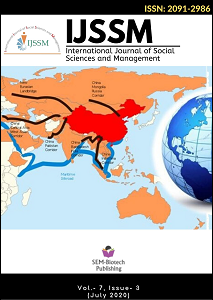Livelihood Dissonance in Sherpa Community
DOI:
https://doi.org/10.3126/ijssm.v7i3.29958Keywords:
Sherpa people, Inhabitants of Himalayas, Climbing Professions, Livelihoods of SherpaAbstract
This study deals with the changing occupations of Sherpa people who has been recognized as 'high altitude porter' for their courage in climbing difficult mountains. After having a lot of in person formal/informal conversation, focus group discussion and in field observations for 15 days with heterogeneous people in Khumbu region of Nepal, the study tried to find reasons of distractions of younger generation in maintaining their ancestral professions. Narrative interview has been conducted with Sherpa mountaineers, business persons, porters, young students and teachers. An effort has been made to analyze the issues of Sherpa community people through cognitive dissonance theory developed by Leon Festinger in 1957. It employs thematic analysis in three categories of participants – professional mountaineers, business people (age: 20 to 35) and high school students (age: 16 to 20) and findings have been discussed under theoretical and policies perspectives. The findings show that Sherpa people are reluctant to continue their ancestral climbing profession because of risks of life, pressure built from their family members, lack of encouragement from the Government and availability of alternatives. The study has reflected many possibilities of future research. The lapses are found in policies, relevant educational curricula, facilities and protection and promotion mechanism of tourism industries, thus, studies in these areas can help shed light on the overall situations of professionalism in this sector.
Int. J. Soc. Sc. Manage. Vol. 7, Issue-3: 159-168
Downloads
Downloads
Published
How to Cite
Issue
Section
License
This license enables reusers to distribute, remix, adapt, and build upon the material in any medium or format for noncommercial purposes only, and only so long as attribution is given to the creator.




